IRST Block II gives the F/A-18 improved optics and processing power to improve pilot situational awareness; it will be delivered to the Navy in 2021.

PATUXENT RIVER NAS, Md. – U.S. Navy air combat experts are asking electro-optics engineers at Lockheed Martin Corp. to build five infrared receivers and four control processors for the infrared search and track (IRST) system aboard F/A-18E/F Super Hornet jet fighter-bomber.
Officials of the Naval Supply Systems Command Weapon Systems Support in Philadelphia announced a $20 million sole-source order Friday to the Lockheed Martin Missiles and Fire Control segment in Orlando, Fla., to provide these IRST components. The IRST enables the F/A-18E/F to detect, track, and attack enemy aircraft in a stealthy way without making its presence known.
The Super Hornet combat aircraft IRST is a long-wave infrared detection sensors system that targets enemy aircraft in conditions where the Super Hornet cannot use its radar.
The system, which Boeing Co. Defense, Space & Security segment in St. Louis is buying from Lockheed Martin, uses infrared search and track technology to detect and provide weapons-quality track solutions on potentially hostile aircraft.
The Navy and Boeing first flew the IRST Block II pod on an F/A-18E/F Super Hornet in late 2019. IRST is a passive, long-range sensor incorporating infrared and other sensor technologies for accurate targeting.

 www.militaryaerospace.com
www.militaryaerospace.com
PATUXENT RIVER NAS, Md. – U.S. Navy air combat experts are asking electro-optics engineers at Lockheed Martin Corp. to build five infrared receivers and four control processors for the infrared search and track (IRST) system aboard F/A-18E/F Super Hornet jet fighter-bomber.
Officials of the Naval Supply Systems Command Weapon Systems Support in Philadelphia announced a $20 million sole-source order Friday to the Lockheed Martin Missiles and Fire Control segment in Orlando, Fla., to provide these IRST components. The IRST enables the F/A-18E/F to detect, track, and attack enemy aircraft in a stealthy way without making its presence known.
The Super Hornet combat aircraft IRST is a long-wave infrared detection sensors system that targets enemy aircraft in conditions where the Super Hornet cannot use its radar.
The system, which Boeing Co. Defense, Space & Security segment in St. Louis is buying from Lockheed Martin, uses infrared search and track technology to detect and provide weapons-quality track solutions on potentially hostile aircraft.
The Navy and Boeing first flew the IRST Block II pod on an F/A-18E/F Super Hornet in late 2019. IRST is a passive, long-range sensor incorporating infrared and other sensor technologies for accurate targeting.

Lockheed Martin to provide infrared search and track avionics components for Navy F/A-18E/F combat jet
IRST Block II gives the F/A-18 improved optics and processing power to improve pilot situational awareness; it will be delivered to the Navy in 2021.


